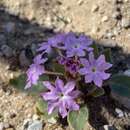Comprehensive Description
(
Inglês
)
fornecido por North American Flora
Tripterocalyx crux-maltae (Kellogg) Standley, Contr. U. S
Nat. Herb. 12: 328. 1909.
Abronia Crux-Maltae Kellogg, Proc. Calif. Acad. 2:71. 1863.
Plants ascending or procumbent, much branched, the branches stout, 1-3 dm. long, viscidvillous with very slender long white hairs or glabrate; petioles 1-4 cm. long; leaf-blades elliptic-oblong, ovate-oblong, broadly ovate, or ovate-rhombic, 2-5 cm. long, 2-3 cm. wide, acute to rounded at the base and often unequal, narrowed to an obtuse apex, bright-green, viscid-pub erulent when young but soon glabrate; peduncles 1-6 cm. long; bracts ovate or lanceolate, 6-10 mm. long, attenuate or long-attenuate, densely viscidvillous; perianth 2-2.5 cm. long, densely long-villous outside or rarely only puberulent, the limb about 1 cm. broad, deeply lobed, bright purplish-pink with a green throat, the lobes deeply bilobate; fruit 1-1.5 cm. long, orbicular or broader than long, the body coarsely transverse-rugose, villous, the 2 wings thin, very coarsely reticulateveined, the veins indurate, puberulent or villous, the margins ciliolate.
Type locality': Carson Valley, Nevada. Distribution: Western Nevada and adjacent California.
- citação bibliográfica
- Paul Carpenter Standley. 1918. (CHENOPODIALES); ALLIONIACEAE. North American flora. vol 21(3). New York Botanical Garden, New York, NY

